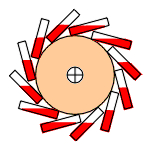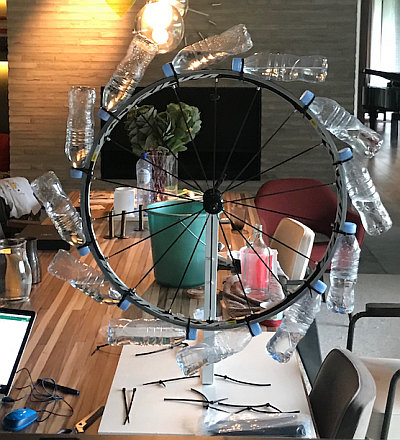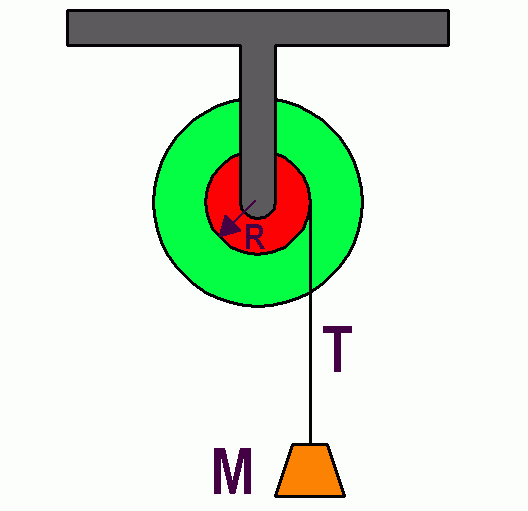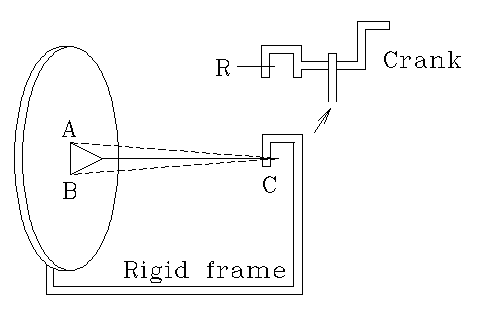Experimental analysis of
the Bhaskara wheel.
Some thoughts on experimentally testing self-motive wheels.
| Caution: Some methods described below incude large weights that fall onto a table, floor or sidewalk from a considerable height. Obviously this can do damage. Provide for the weights to fall into a padded container, or one filled with sand. |
 |
| Fig. 1. Bhaskara's wheel. Graphic © Hans-Peter Gramatke. |
|---|
The oldest perpetual motion designs we know of are the wheels of the mathematician-astronomer Bhaskara (c.600 – c.680). Bhaskara's wheels were of two kinds. One had curved hollow spokes partly filled with a liquid. The other had tilted bottles around the rim, partly filled with liquid. The assumed principle of operation was the same in both.
Over the centuries similar ideas cropped up frequently. Believers in this idea explained how they thought it would work.
- The tilt of the bottles ensures there's continually more weight of liquid on one side of the wheel's axle, maintaining the wheel's rotation.
- The liquid in the bottles on one side of the axle is farther from the axle so there is greater net torque on that side, continually unbalancing the wheel and maintaining its rotation.
- As each bottle moves across the top, liquid moves quickly to the other end of the bottle, giving the wheel a forward push that maintains the wheel's motion.
The Bhaskara wheel is simple to build. The web has many examples, and videos of bicycle wheels with tilted bottles of liquid evenly spaced around the rim. Some of these videos show the wheels turning. Many of these are deliberately faked. The honest videos show that the wheels come to rest in minute or so. Even the honest builders usually don't bother to take data and don't design an experimental strategy to find out why they behave as they do. They are only interested in showing that the Bhaskara wheel doesn't work as claimed. They are missing an intstructive example of how to do experimental research on a small budget.
|
Berend Van Nieuwland built a modern re-construction of the Bhaskara wheel and sent this data to me (2018). The volume of liquid is the fraction of bottles filled with liquid. An empty bottle is zero, a full bottle is 1. When graphed, running time vs. volume, this reveals an upward rising curve, increasing its slope with larger volume. Here's where this gets interesting. Berend wonders why increased mass seems to increase the wheel's performance. He says that the initial conditions (giving the wheel a spin) were the same in all trials.
 |
| Fig. 2. Bicycle wheel with water bottles. Built by Berend Van Nieuwland. |
|---|
I wasn't surprised. I've often said, The best perpetual motion wheel is a simple flywheel on a frictionless axle. Any gimmicks you add, shifting liquid, shifting masses, articulated hammers, rolling balls, etc., make the wheel perform worse. This wheel's best performance should be with full bottles, where there's no motion of the liquid, or with empty bottles where there's no liquid to move.
The wheel should also perform best when the bottles are empty, compared to partially filled bottles. Clearly the total mass of added water is at least partly responsible for the volume dependence shown in the data. What is the reason for this? How does mass of liquid affect performance?
The extra mass adds load on the axle, increasing the friction there. We expect this would make the wheel stop sooner when we add liquid. It doesn't. But adding liquid makes the wheel spin longer. Assuming the data is correct, something else must also be going on. It is this sort of thing that convinces some perpetual motion machine inventors to think they are onto something—that some mysterious force is trying to sustain the wheel's motion working against friction, and with a bit of tweaking, might produce perpetual motion or over-unity performance.
What is the reason for Berend's experimental result? What experimental testing procedure might reveal the reason?
After I received the data above, Berend informed me that his method for starting the wheel was to give it a push by hand. That makes the data of negligible value. We need a better, consistent starter and experimental strategy. It would be nice to devise a strategy applicable to any allegedly self-motive wheel. Let's consider various approaches that can test such allegedly self-motive wheels, with simple and inexpensive materials and measuring instruments. This will lead us to a simple testing method that can be applied to many perpetual motion wheel designs.
Testing the wheel.
Perpetual motion machine inventors sometimes deceive themselves when they test their machines. We describe here a method appropriate for measuring the performance of wheel-type devices.The strategy is this: Give the wheel an initial rotational kinetic energy, then time how long it takes to come to rest. The longer it takes to stop, the better its performance. Do this for different internal mechansim variations to see which peform best, being careful that the starting device gives the wheel the same inpput energy each time.
Some inventors choose to start the wheel with the same speed (RPM) in each case. This method isn't easy to analyze, for the initial kinetic energy of the wheel is dependent on its total mass. So in trials with different wheel mass the initial kinetic energy won't be the same in all cases. I don't recommend this for it is not precisely reproducible.
A standard method is to start the wheel with energy supplied by a falling weight. The weight, of mass M is on one end of a string, the other end wrapped around a shaft that rotates with the wheel. When the weight reaches the floor, after falling a distance H the string falls free. This gives the wheel an energy MgH where g is the acceleration due to gravity.
We need a starter that provides the same initial energy to the wheel in all trials. We'll discuss some methods later.
Now for the tests.
Test the starter for consistency. Repeat the test 10 times, so see how much variation there is in the stopping times. This should be done for every subsequent test.
Test the wheel for both directions of rotation. Inventors assume that their design favors motion in one direction. If the stopping times are the same in either direction, this design isn't perpetual mitoon.
Add "improvements" to the wheel, vary the size of the shifting masses, their linkages, and their constraints, and compare different lubricants.
Lock down the internal shifting masses so they cannot move (or remove them entirely). If this improves performance, then the motion of those shifty masses is not doing anything useful.
Falling weight starter.
 |
| Fig 4. Falling weight suspended from axle. |
|---|
A classic method of starting a wheel uses a falling weight to impart the starting boost. The weight is suspended by a cord wrapped around the narrow axle of the wheel. If the weight M falls a vertical distance H before it detaches, it has given the wheel mgH of energy, whatever the wheel's mass may be, and whatever clever mechansim the wheel has that supposedly gives it a power boost. Now measure how long the wheel takes to come to a stop.
For heavy wheels the axle radius R should be much smaller than shown in Fig. 4, perhaps only a half inch or less.
Rubber band starter.
 |
| Fig 3. Rubber band starter. |
|---|
Here's a method, shown in Fig. 3, that uses a spring or rubber band to start the wheel. A rubber band is attached at ponts A and B on the wheel. The other end of the band loops around a pin at C, and in the unstretched position (dotted lines) is just long enough to reach the pin, but not taught enough to prevent it falling off the pin. The wheel is turned and the band twists under increasing tension, keeping it looped over the pin C, assuming the apperance shown as solid lines. When wound enough (count the revolutions), we stop, then release the wheel. The band untwists, until it falls free of the pin, and wheel spins freely.
In the inset at uppper right we show an alternative method that uses a crank to wind the rubber bands. In any of these testing methods such a crank is very helpful during the starting process to wind the starter.
A simpler strategy, using a weight attached to the wheel.
Fred Bucheit suggested a simpler starter for the wheel. Place an extra weight of mass M on the rim of the wheel at startng position S. The wheel is released and when it reaches the bottom point B, the weight falls free, allowing the wheel to rotate on its own. Designing a method for a clean separation from the wheel at a precise point would be tricky. That might require a trigger mechanism.The method of starting the wheel with a falling weight on a string wrapped around a small axle of the wheel is equivalent to this.
There are practical differences, however. The weight-on-the-wheel method allows the weight to fall almost 2D, where D is the wheel diameter. But in the axle-drfiven falling weight methods one could have several stories of drop if you set it up so the weight falls down a stairwell, or outside an upper floor window or balcony. The string could even go over a horizontally displaced pulley to facilitate this. The axle-driven methods do allow for simple, easy release of the weight at a fixed point.Let's examine what we are testing. We know that a rotating wheel stops after a time due to dissipative processes like friction, repeated impacts of moving parts, etc. The PMM believer supposes that some clever design of the wheel, usually with moving parts, gives the wheel an additional and continuous push that can overcome those dissipative processes, resulting in a wheel that turns forever at constnat speed. Or, if the push is greater, allow the wheel to increase its speed continually. This can produce power output that can power other machinery, or drive a generator to supply electrical power. Our task is to see whether those special internal mechanisms are actually supplying motive power to the wheel.
 |
| Fig 5. Attached weight starter. |
|---|
So we measure how long the wheel takes to stop after an initial calibrated push (energy from the starting mechanism). The longer the time, the "better" the performance. That is the hope.
We can also compare performance in another way. The starting process itself is all we need. As the starter weight falls, we measure how long it takes to fall a fixed distance. The input energy is MgH where M is the falling mass and H is the distance it falls. We keep that constant in all trials. This method does not require timing how long the wheel takes to stop. But why not do both while we are at it?
Performance is inversely dependent on time of fall of the falling mass,M. If it takes longer to fall in trial B compared to trial A, then the performance is worse in trial B.
So much for measurements. We will, I expect, find that the performance of a simple wheel with no gimmicks is best. Performance of the gimmicked wheel will be the same in either direction of rotation.
This method could be applied to any wheels claimed to be self-motive wheels.
The Bhaskara wheel has tilted bottles half-filled with water around the rim. I suggest measuring the performance of it, as described above. Now replace the bottles with other identical ones, with the same amount of water, frozen. I predict the frozen bottles will perform best. If so, this demolishes the notion that the liquid water sloshing from one end of each bottle to the other is a source of extra "push" on the wheel.
In any case, starting the wheel by giving it a push by hand is not reproducible enough to provide any useful evidence.
Many wheels, including the Bhaskara and Villard wheels have shifting masses that result in a "jerky" motion. For testing, start their motion at their position of greatest instability.
Don't overlook the obvious.
Unless you use a very large weight or distance of its fall, H, the wheel will likely not make even one revolution, and will rise a distance E to position F from the reference level. The system has lost Mg(H-F) of energy. From measurement of height E we can measure the relative performance of various wheel modifications. The greater E, the better the wheel's performance. This may be the most practical method, requiring no precision timing mechanism or mass release device. When making comparisons the starting conditions must be constant in each trial. And, as always, each trial should be repeated and recorded perhaps 10 times or more, so you can determine the uncertainty (variability) of the average of the results of each experimental setup.
Getting off to a good start.
All of these allegedly self motive wheels have positions of stable equilibrium. If there are 8 bottles of liquid around the rim there will be 8 positions of stable equilibrium, located between 8 positions of unstable equilibrium where one bottle passes over the top and its liquid shifts from one end of the bottle to the other. For the Villard wheel, choose the point where one hammer flips across the top. Ideally you should start the wheel by releasing it when it is at one of those unstable positions. The position should be located and marked.One must start the wheel with enough initial energy to give it sufficient speed that it completes nearly a full revolution before stopping. It is more impressive if it completes several revolutions. Just increase the starter's weight until it is sufficient for your measuring method.
Silent running.
An ideal perpetual motion wheel would be completely silent, for sound represents a loss of energy from the wheel. Anyone who has built one of these, say the Villard wheel with flipping hammers, knows they can be very noisy. The noise is from solid hammers impacting the solid wheel. Could we make such wheels run silently, and would this improve their performance?We could, but it wouldn't help performance. Try soft rubber bumpers padding the places where solid parts impact. Performance will be no better, likely worse, because solid objects striking soft surfaces convert mechanical energy to heat. Nature has gotcha again.
Sloshing liquids also cause viscous heating. Freeze the liquid so it can't move and see what an improvement that makes.
Quibbles.
PMM inventors (believers) are often critical of the validity of testing methods. Anything that does not support their belief is declared incorrect or invalid. They willl never be convinced by any math, phyiscs or experiment. If the added falling weight remains attached to the wheel the wheel may not rise to the top, T, to start another cycle. It will only rise to a finishing position at F. Believers will declare that the weight must go over the top before the magical impetus that makes the wheel self-motive will take effect. They will also insist that measurements be taken after starting the wheel, not during the starting process.To satisfy them, one can increase the mass M of the falling weight until the wheel completes several revolutions. Or devise a reliable trigger mechanism to release the weight reproducibly at the bottom position B. If the method of using weight on a string wrapped around the axle is used, use a larger weight and allow it to fall before the string falls free. Do the experiment from an upper story balcony, or in a tall stairwell Then measure how long the wheel takes to come to a stop (and it will).
In all such tests the wheel's axle must be solidly fixed and unmoving. Bolt the apparatus to a solid support, or add weight to its base so it doesn't move.
Additional uses of these methods.
One could investigate methods to reduce friction. Does lubrication really improve performance of the wheel? Experience tells us it will not. Dry bearings with with very smooth finish work best for light loads. Lubrication only increases viscosity. We can test this for lightly and heavily loaded bearings.
Skeptical look.
One should always skeptically look at experimental procedure to ensure you've not overlooked something. Let's start a list of things to consider.- Does the starter mechanism load the wheel's bearings? If so, does it matter?
- Does the starter mechanism release part of its potential energy to something other than the wheel (thermal energy, for example)? If so, does it matter?
- Wheels being compared have different masses and different configurations of their parts. They will take different times to start and will have different initial speeds after starting. Does this matter.
Return to Donald Simanek's front page.
Return to The Museum of Unworkable devices.
Return to the top of this document.